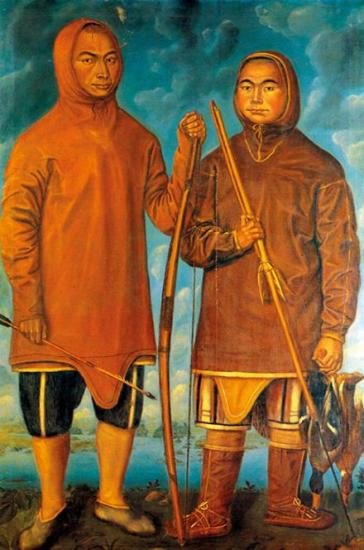A recent archaeological find in Copenhagen – a bird spear from the Thule culture – has put focus on expeditions to rediscover Greenland 400 years ago and the expeditions’ kidnapping of Greenlanders.
Jens Winther Johannesen / Translated by Michael de Laine
Source -http://sciencenordic.com/did-recently-found-bird-spear-belong-kidnapped-greenlander

Part of a double portrait from 1724, after the Lutheran missionary Hans Egede founded, in 1721, Håbets koloni (Hope colony) on Kangeq Island at the mouth of the Nuuk Fjord (formerly known as Godthaab Fjord) in south-western Greenland. (Illustration: National Museum).
The ongoing excavations for a new metro line in Copenhagen are revealing new knowledge about the fortifications of the Danish capital.
These excavations, which will last for several years, are also telling us about other aspects of life in the city, as the moats that formed part of the fortifications were filled with all forms of rubbish that was at hand when they were taken out of use.
Useful items also ended up in the moats from time to time.
One of the more unusual finds is part of a bird spear from Greenland, which was found in Kongens Nytorv, a major square in Copenhagen.
Common Greenland hunting tool
The bird spear was a common hunting tool in Greenland from around 1500 to some time in the 1900s.
Apart from the spearhead itself, the bird spear typically had three or four side prongs fixed to the middle section of the shaft.
These increased the hunter’s chances of success when he launched the spear into a flock of birds, and it is one of these side prongs that came to light during the excavations in the Copenhagen underground.
It was found in a moat that was once part of the fortifications around Copenhagen built by King Christian IV.
In the same layer of soil there were pieces of ceramics and tiles from the first half of the 17th century. The bird spear prong thus likely dates from the same period.
Thule culture find in Denmark a result of kidnapping
This is quite likely the first time that an item from the Thule culture in Greenland has been found in an excavation in Denmark.
That a hunting spear like this turns up in Copenhagen, thousands of kilometres from its origin, is probably due to kidnapping.
Following Columbus’ discovery of America, it was commonplace for Europeans who colonised tracts of land on the American continents to kidnap ‘savages’ and take them home to show to the monarch and the people – thus demonstrating the strength and sovereignty of the colonial power.
Columbus, for example, brought home a group of Arawak Indians following his first expedition, and Amerigo Vespucci brought home over 200 people from the New World in the years around 1500.
When, 100 years later, Christian IV took the initiative to rediscover the Greenland of the sagas, people only had a vague idea of the cold country in the North Atlantic Ocean.
The first expedition – commanded by the Scot John Cunningham and with the Englishman James Hall as the pilot – set off in 1605. The Dane Godske Lindenov captained the Røde Løve (Red Lion), which was one of the expedition’s three ships.
The participants reached such a great degree of disagreement during the voyage that Lindenov’s ship left the rest of the expedition off Greenland’s south-western coast.

The bird spear side prong found at Kongens Nytorv is reminiscent of the tip of a harpoon. It was made from a bone from a large mammal. (Photo: Museum of Copenhagen.)
The Røde Løve soon cast anchor in a fjord in south-western Greenland – probably Qeqertarsuatsiaat Kangerlluat.
Traded with Greenlanders, then kidnapped them
The mariners met Greenlanders and started trading with them. Shortly before setting sail for Denmark, Lindenov’s crew kidnapped two Greenlanders, probably both men, as living proof that Greenland had been rediscovered.
The Greenlanders fought back, one receiving wounds, and both were then tied up.
The Røde Løve’s arrival in Copenhagen on 28 July 1605 was the centre of much attention. People gathered on the quay and King Christian IV and Queen Anna Cathrine visited the ship to see the two Greenlanders, who later demonstrated their kayaks in Copenhagen’s harbour.
At some point the two Greenlanders were separated, and one was sent to Arild Huitfeld, one of the king’s Lord Lieutenants, at Dragsholm castle to learn Danish. We know nothing more about these two Greenlanders.
Two weeks after the Røde Løve’s arrival, on 10 August 1605, the rest of the expedition arrived in Copenhagen.
The last two ships had been further north, to the Itivdleq Fjord south of Sisimiut.
They had also met Greenlanders, with whom they exchanged nails and old iron for clothing, tools, sealskins and narwhal tusks. They kidnapped four Greenlanders just before they returned home.
Strong, homesick Greenlanders
On board the ship, the Greenlanders fought back, and the captain shot one of them. The dead body was thrown overboard, and the remaining Greenlanders were either tied up or locked up.
The three survivors are called Orm, Oye and Judecha in contemporary texts, which would be Umik, Oqaq and Kigutikkaaq today.
According to Jens Bielke, the secretary of Danske Kancelli (the Danish Chancery, the only government office for the Kingdom of Denmark until the Constitution of 1849), the Greenlanders were extremely strong, and he described how the Greenlanders could row as fast in their kayaks as ten of the king’s boatmen.
Although the Greenlanders were described as cheerful, they suffered greatly from homesickness and at one point they tried to escape in an umiak, also known as a women’s boat, which they had built during their stay in Denmark.
However, bad weather forced them to give up their escape attempt and they landed in the southern Swedish region of Skåne (Scania), where they stayed with local farmers until they were brought back to Copenhagen.
PART. 2